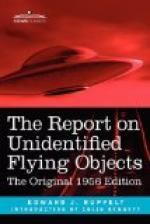To weed out reports in which balloons, airplanes, and astronomical bodies were reported as UFO’s, we utilized a flow of data that continually poured into Project Blue Book. We received position reports on all flights of the big skyhook balloons and, by merely picking up the telephone, we could get the details about the flight of any other research balloon or regularly scheduled weather balloon in the United States. The location of aircraft in an area where a UFO had been reported was usually checked by the intelligence officer who made the report, but we double-checked his findings by requesting the location of flights from CAA and military air bases. Astronomical almanacs and journals, star charts, and data that we got from observatories furnished us with clues to UFO’s that might be astronomical bodies. All of our investigations in this category of report were double-checked by Project Bear’s astronomer.
Then we had our newspaper clipping file, which gave us many clues. Hydrographic bulletins and Notams (notices to airmen), published by the government, sometimes gave us other clues. Every six hours we received a complete set of weather data. A dozen or more other sources of data that might shed some light on a reported UFO were continually being studied.
To get all this information on balloons, aircraft, astronomical bodies, and what have you, I had to co-ordinate Project Blue Book’s operational plan with the Air Force’s Air Weather Service, Flight Service, Research and Development Command, and Air Defense Command with the Navy’s Office of Naval Research, and the aerology branch of the Bureau of Aeronautics; and with the Civil Aeronautics Administration, Bureau of Standards, several astronomical observatories, and our own Project Bear. Our entire operational plan was similar to a Model A Ford I had while I was in high school—just about the time you would get one part working, another part would break down.
When a report came through our screening process and still had the “Unknown” tag on it, it went to the MO file, where we checked its characteristics against other reports. For example, on May 25 we had a report from Randolph AFB, Texas. It went through the screening process and came out “Unknown”; it wasn’t a balloon, airplane, or astronomical body. So then it went to the MO file. It was a flock of ducks reflecting the city lights. We knew that the Texas UFO’s were ducks because our MO file showed that we had an identical report from Moorhead, Minnesota, and the UFO’s at Moorhead were ducks.
Radar reports that came into Blue Book went to the radar specialists of ATIC’s electronics branch.
Sifting through reams of data in search of the answers to the many reports that were pouring in each week required many hours of overtime work, but when a report came out with the final conclusion, “Unknown,” we were sure that it was unknown.




